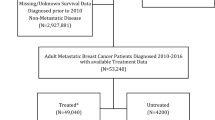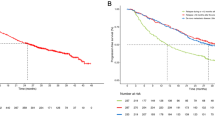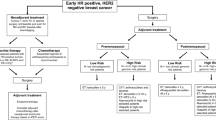Abstract
Fenretinide and tamoxifen have additive antitumor effects preclinically. We performed a randomized, placebo-controlled, double-blind adjuvant trial in breast cancer patients treated for 5 years with tamoxifen, with or without fenretinide. Between October 1995 and October 1999, 426 postmenopausal women with hormone receptor-positive breast cancer were randomized. Patients were monitored for efficacy and toxicity. Four hundred and nineteen patients were evaluable. The study was terminated early due to slow accrual. There were no significant differences between treatment groups in DFS, TTR or survival. More patients stopped treatment early on the fenretinide arm than on placebo (P = 0.02). Grade 3/4 toxicities, including visual problems and musculoskeletal complaints were more common in patients receiving fenretinide (P = 0.007). A Night Blindness Questionnaire was used to monitor nyctalopia, which was slightly, but not significantly, more common on fenretinide. In this underpowered study, no significant difference was observed in efficacy between treatment groups. This trial provides important toxicity information about fenretinide, a retinoid that has been used in the prevention setting, because it is the only placebo-controlled, double-blind randomized study ever performed.




Similar content being viewed by others
References
Early Breast Cancer Trialists’ Collaborative Group. Tamoxifen for early breast cancer: an overview of the randomised trials. Lancet. 1998;351:1451–67.
Cobleigh ML. Breast cancer and fenretinide, an analogue of vitamin A. Leukemia. 1994;8 (suppl 3):S59–63.
Mehta RG, Moon RC, Hawthorne M, et al. Distribution of fenretinide in the mammary gland of breast cancer patients. Eur J Cancer. 1991;27:138–41.
Moon RC, Thompson HJ, Becci PJ, et al. N-(4-hydroxyphenyl) retinamide, a new retinoid for prevention of breast cancer in the rat. Cancer Res. 1979;39:1339–46.
Dowlatshahi K, Mehta R, Thomas C, et al. Therapeutic effect of N-(4-hydroxyphenyl) retinamide on N-methyl-N-nitrosurea-induced rat mammary cancer. Cancer Lett. 1989;47:187–92.
Moon RC, Pritchard JF, Mehta RG, et al. Suppression of rat mammary cancer development by N-(4-hydroxyphenyl) retinamide (4-HPR) following surgical removal of first palpable tumor. Carcinogenesis. 1989;10:1645–9.
Green A, Shilkaitis A, Christov K. 4-(Hydroxyphenyl) retinamide selectively inhibits the development and progression of ductal hyperplastic lesions and carcinoma in situ in mammary gland. Carcinogenesis. 1999;20:1535–40.
Ratko TA, Detrisac CJ, Dinger NM, et al. Chemopreventive efficacy of combined retinoid and tamoxifen treatment following surgical excision of a primary mammary cancer in female rats. Cancer Res. 1989;49:4472–6.
Veronesi U, De Palo G, Marubini E, et al. Randomized trial of fenretinide to prevent secondary breast malignancy in women with early breast cancer. J Natl Cancer Inst. 1999;91:1847–56.
McCormick DL, Mehta RG, Thompson CA, et al. Enhanced inhibition of mammary carcinogenesis by combined treatment with 4-HPR and ovariectomy. Cancer Res. 1982;42:508–12.
McCormick DL, Sowell ZL, Thompson CA, et al. Inhibition by retinoid and ovariectomy of additional primary malignancies in rats following surgical removal of the first mammary cancer. Cancer. 1983;51:594–9.
Welsch C, Brown C, Goodrich-Smith, et al. Synergistic effect of chronic prolactin suppression and retinoid treatment in the prophylaxis of N-methyl-N-nitrosurea-induced mammary tumorigenesis in female Sprague-Dawley rats. Cancer Res. 1980;40:3095–8.
Budd GT, Adamson PC, Gupta M, et al. Phase I/II trial of all-trans-retinoic acid and tamoxifen in patients with advanced breast cancer. Clin Cancer Res. 1998;4:6635–42.
Cobleigh MA, Dowlatshahi K, Deutsch TA, et al. Phase I/II Trial of tamoxifen with or without fenretinide, an analog of vitamin A, in women with metastatic breast cancer. J Clin Oncol. 1993;11:474–7.
Lotan J. Retinoids and apoptosis: implications for cancer chemoprevention and therapy. J Natl Cancer Inst. 1995;87:1655–7.
Seewaldt VL, Johnson BS, Parker MB, et al. Expression of the retinoic acid receptor β mediates retinoic acid-induced growth arrest and apoptosis in breast cancer cells. Cell Growth Differ. 6:1077–88.
Wang TT, Phang JM. Effect of N-(4-hydroxyphenyl) retinamide on apoptosis in human breast cancer cells. Cancer Lett. 1996;107:65–71.
Sun SY, Li W, Yue P, et al. Mediation of N-(4-hydroxyphenyl) retinamide induced apoptosis in human cancer cells by different mechanisms. Cancer Res. 1999;59:2493–8.
Srivastava RK, Srivastava AR, Cho-Chug YS, et al. Synergistic effects of retinoic acid and 8-chloro-adenosine 3′,5′-cyclic monophosphate on the regulation of retinoic acid receptor β and apoptosis: involvement of mitochondria. Clin Cancer Res. 1999;5:1892–904.
Oridate N, Lotan D, Xu XC, et al. Differential induction of apoptosis by all-trans-retinoic acid and N-(4-hydroxyphenyl) retinamide in human head and neck squamous cell carcinoma cell lines. Clin Cancer Res. 1996;2:855–63.
Poot M, Hosier S, Swisshelm K. Distinct patterns of mitochondrial changes precede induction of apoptosis by all-trans-retinoic acid and N-(4-hydroxyphenyl) retinamide in MCF7 breast cancer cells. Exp Cell Res. 2002;279:128–40.
Favoni R, de Cupis A, Bruno S, et al. Modulation of the insulin-like growth factor-I system by N-(4-hydroxyphenyl)-retinamide in human breast cancer cell lines. Br J Cancer. 1998;77:2138–47.
Hankinson SE, Willet WC, Colditz GA, et al. Circulating concentrations of insulin-like growth factor I and risk of breast cancer. Lancet. 1998;351:1393–6.
Torrisi R, Parodi S, Fontana V, et al. Effect of fenretinide on plasma IGF-I and iGFBP-3 in early breast cancer patients. Int J Cancer. 1998;76:787–90.
Decensi A, Veronesi U, Miceli R, et al. Relationships between plasma insulin-like growth factor-I and insulin-like growth factor binding protein-3 and second breast cancer risk in a prevention trial of fenretinide. Clin Cancer Res. 2003;9:4722–9.
Decensi A, Johansson H, Miceli R, et al. Long-term effects of fenretinide, a retinoic acid derivative, on the insulin-like growth factor system in women with early breast cancer. Cancer Epidemiol Biomarkers Prev. 2001;10:1047–53.
American Joint Committee on Cancer. AJCC cancer staging manual. Philadelphia, PA: Lippincott-Raven; 1997.
Zelen M. The randomization and stratification of patients to clinical trials. J Chronic Dis. 1974;27:365–75.
Kaplan EL, Meier P. Nonparametric estimation of incomplete observations. J Am Stat Assoc. 1958;53:457–81.
Mantel N. Evaluation of survival data and two new rank order statistics arising in its consideration. Cancer Chemother Rep. 1966;50:163–70.
Cox DR. Regression models and life tables. J R Stat Soc Ser B. 1972;34:187–220.
Decensi A, Robertson C, Guerrieri-Gonzaga A, et al. Randomized double-blind 2 x 2 trial of low-dose Tamoxifen and Fenretinide for breast cancer prevention in high-risk premenopausal women. J Clin Oncol. 2009;27:3749–56.
Mariani L, Formelli F, De Palo G, et al. Chemoprevention of breast cancer with fenretinide (4-HPR): study of long term visual and ophthalmologic tolerability. Tumori. 1996;82:444–9.
Camerini T, Mariani L, De Palo G, et al. Safety of the synthetic retinoid fenretinide: Long-term results from a controlled clinical trial for the prevention of contralateral breast cancer. J Clin Oncol. 2001;19:1664–70.
Author information
Authors and Affiliations
Corresponding author
Additional information
This study was conducted by the Eastern Cooperative Oncology Group (Robert L. Comis, M.D., Chair) and supported in part by Public Health Service Grants CA23318, CA66636, CA21115, CA47559, CA07968, CA04919, CA25224, and CA37404 and from the National Cancer Institute, National Institutes of Health and the Department of Health and Human Services. Its contents are solely the responsibility of the authors and do not necessarily represent the official views of the National Cancer Institute.
Study has also been published in abstract form: Cobleigh M, Gray R, Graham M, et al.: Fenretinide (FEN) vs. placebo in postmenopausal breast cancer patients receiving adjuvant tamoxifen (TAM), an Eastern Cooperative Oncology Group Phase III Intergroup Trial (EB193, INT-0151). Proc Am Soc Clin Oncol, 2000 (abstr).
Appendix: Night Blindness Questionnaire
Appendix: Night Blindness Questionnaire
Initially, the NBQ consisted of the 6 questions below. Patients could answer TRUE or FALSE to each. In 1996, items 1 and 3 were dropped.
-
1.
I see better in normal daylight than in the evening.
-
2.
I don’t adapt easily when going from a bright area to a dim one (for example, when driving into a tunnel during the daylight or going into a movie theater when a film is being shown).
-
3.
I see poorly in the dark (for example, when getting up at night to go to the bathroom or looking for a light switch in the basement).
-
4.
I have difficulty driving at night.
-
5.
When I am in dim light, I can’t distinguish the outlines of objects well.
-
6.
When I pass from a dimly lit room or place to a strongly lit one, I am dazzled (for example, when leaving a tunnel or leaving a subway station during daylight).
Rights and permissions
About this article
Cite this article
Rao, R.D., Cobleigh, M.A., Gray, R. et al. Phase III double-blind, placebo-controlled, prospective randomized trial of adjuvant tamoxifen vs. tamoxifen and fenretinide in postmenopausal women with positive receptors (EB193): an intergroup trial coordinated by the Eastern Cooperative Oncology Group. Med Oncol 28 (Suppl 1), 39–47 (2011). https://doi.org/10.1007/s12032-010-9682-1
Received:
Accepted:
Published:
Issue Date:
DOI: https://doi.org/10.1007/s12032-010-9682-1




